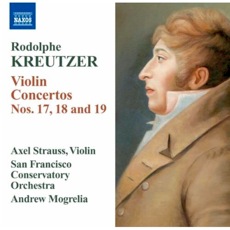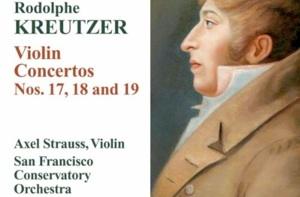
The composer names that loom large in the minds of musicians aren’t always the ones the listening public knows well. Czerny and Burgmüller are names that pianists know, but classical piano listeners might not. In the same way, Rodolphe Kreutzer and Pierre Rode and Giovanni Battista Viotti are pretty much off the public’s radar, but very much on the violin student’s — the first two for volumes of studies that are obligatory, the last for a pair of concertos that are nearly likewise.
But this is all as study material, not for public performance (Viotti’s 22nd Concerto makes the very occasional appearance in public — an odd fate for a piece that Johannes Brahms admired).
We have the odd circumstance of a respected bunch of violinist-composers (Vivaldi, Locatelli, Tartini) who get programmed, another much later bunch (Vieuxtemps, Wieniawski, Ernst, Ysaÿe, and a number of others) who also get programmed, and, really, only Paganini in between. I think the gap has to do with the early-19th-century violinist-composers devoting themselves so much to pedagogy. No one really wants to show off with a concerto written by the guy whose études everyone is forced to work through.
Which is why Axel Strauss’ latest Naxos CD is so valuable. The one before merely (merely!) showed what music could be made out of Pierre Rode’s solo violin caprices. But those are familiar material, if only to violin students. This time, he takes on Kreutzer, but not the 42 Caprices in every violinist’s case pocket; here we have three violin concertos (the three last, we’re told), accompanied by the San Francisco Conservatory Orchestra under Andrew Mogrelia.
Listen To The Music
Violin Concerto No. 17 In G Major - RondoStrauss is fantastic here. The two things that stand out are the incredible nimbleness in both hands and the utterly lovely cantabile. Every dotted rhythm (and they’re all over the place) is perfectly pointed, and every melodic line is shaped and caressed as though Strauss were singing it. Plus, there are all those incredibly finicky little bits of filigree that were the violinist-composer’s stock in trade for at least a couple of generations. If you smudge anything in such a passage, it’s dead. Strauss doesn’t; what’s more, he gives the impression that you could make him play it 20 times over and it would always be that clean.
The thing is, he has much to be fantastic about. Kreutzer wrote this music for his own use, and in the hands of anyone who can play like Strauss, it’s much more than useful; it’s full of beauties and, indeed, drama. The singing lines really do sing; the dances (the 17th Concerto ends with a dramatic Boléro) really do dance; and the orchestral introductions really do introduce, at length and with intelligence.
The one small disappointment is the Conservatory Orchestra. The winds are magnificent, but the strings — how to put it? — sound like they are accompanying even when they aren’t. I would’ve hoped that some of Strauss’ subtlety of inflection (he leaves nothing alone, regards no note as unimportant) had rubbed off in the sessions, but the strings — tight, in tune, and stylish as they are — don’t treat the music anything like as seriously as their soloist does. It is all rather generic. Too bad.
Naxos apparently intends to record the rest of the Kreutzer concertos, though it has not announced with whom. Here’s hoping for more Strauss; but if there are other interested violinists who can play like that, here’s waiting, in any case, for more Kreutzer.

